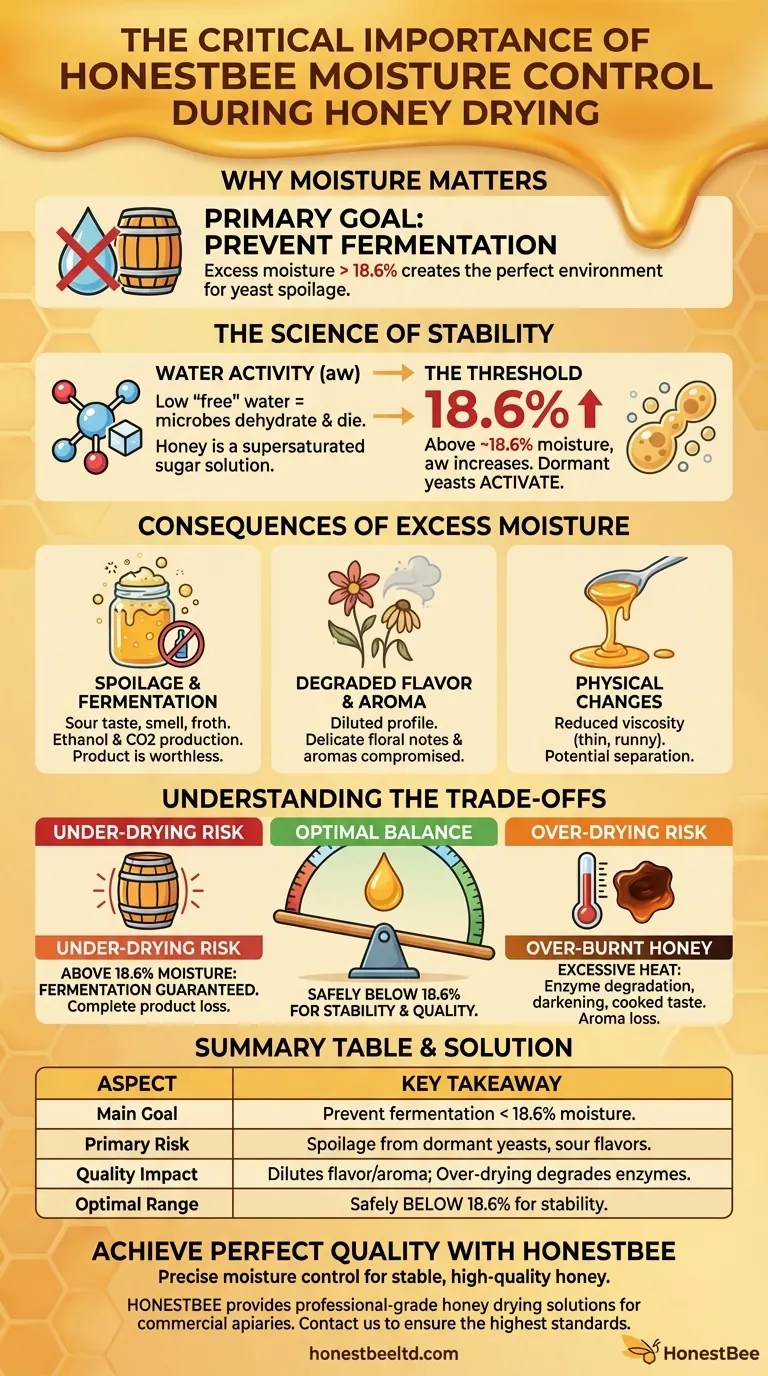The primary reason for controlling moisture during honey drying is to prevent fermentation. Honey with a moisture content that is too high provides the perfect environment for naturally present yeasts to activate and multiply. This process spoils the honey, creating sour off-flavors and rendering it unusable for consumption or sale.
Honey's natural longevity is a direct result of its low water content, which creates an environment where microbes cannot survive. The act of drying honey isn't just about removing water; it is the critical step that ensures this microbial stability, protecting the honey's quality, value, and shelf life.

The Science of Honey Stability
To understand why moisture is so critical, you must first understand the principle that makes honey so remarkably stable. Honey is a supersaturated sugar solution, which is its primary defense mechanism.
Understanding Water Activity
The key concept is not just the total amount of water, but its water activity (aW)—the "free" or available water that microbes can use for growth.
In honey, sugar molecules hygroscopically bind to water molecules. This leaves very little free water available, resulting in a low water activity that effectively dehydrates and kills most bacteria and yeast.
The Threat of Dormant Yeasts
Honey naturally contains osmophilic yeasts—microbes that are uniquely adapted to survive in high-sugar environments.
While honey's low water activity keeps these yeasts dormant, they are not eliminated. They simply wait for conditions to become favorable for growth.
The Fermentation Threshold
When the moisture content of honey rises above approximately 18.6%, the water activity increases to a critical point.
This provides enough free water for dormant osmophilic yeasts to activate. They begin to metabolize the honey's sugars, initiating the process of fermentation.
How Excess Moisture Compromises Honey Quality
Allowing moisture levels to remain too high has several direct, negative consequences that degrade the final product.
Spoilage Through Fermentation
This is the most severe outcome. As yeasts consume glucose and fructose, they produce ethanol (alcohol) and carbon dioxide.
This process gives the honey a distinct sour or fermented taste and smell, often accompanied by froth or bubbles. The honey is considered spoiled and is commercially worthless.
Degradation of Flavor and Aroma
Even before full fermentation occurs, excess moisture can dilute the honey's profile. The delicate volatile compounds responsible for its unique floral notes and aroma are compromised.
The result is a less vibrant and less characteristic product that has lost much of its premium quality.
Changes in Physical Properties
High moisture content directly reduces honey's viscosity, making it thin and runny. This can be perceived as a sign of low quality.
It can also affect the natural process of crystallization, sometimes leading to separation of the liquid and solid phases, which is undesirable.
Understanding the Critical Trade-offs
Achieving the perfect moisture level is a balancing act. Both under-drying and over-drying introduce significant risks to your final product.
The Risk of Under-Drying
This is the most immediate danger. Leaving too much water in the honey, especially above the 18.6% threshold, almost guarantees fermentation during storage.
This leads to complete product loss, wasted effort, and potential damage to storage containers from pressure buildup caused by carbon dioxide.
The Risk of Over-Drying
Conversely, being too aggressive with drying can also damage the honey. Applying excessive heat to speed up moisture removal degrades the honey's natural enzymes, such as diastase and invertase.
Over-drying can also darken the honey's color and drive off the subtle aromatic compounds that define its flavor, resulting in a product with a cooked or diminished taste.
Making the Right Choice for Your Goal
Your approach to moisture control should be guided by your end goal for the honey. A controlled drying process is essential for a high-quality, stable product.
- If your primary focus is long-term stability and commercial sale: Your absolute priority is to ensure the moisture content is safely below 18.6% to eliminate any risk of fermentation.
- If your primary focus is preserving delicate flavor profiles: Utilize a low-temperature drying method that removes moisture gradually, preventing heat damage to sensitive enzymes and aromas.
- If you are dealing with "unripe" honey (harvested early): Aggressive moisture reduction is necessary to bring the high initial water content down to a safe level for storage and prevent rapid spoilage.
Ultimately, precise moisture control is the defining process that transforms a perishable raw product into a stable and valuable food.
Summary Table:
| Aspect | Key Takeaway |
|---|---|
| Main Goal | Prevent fermentation by keeping moisture content below 18.6%. |
| Primary Risk | Spoilage from dormant yeasts, leading to sour flavors and product loss. |
| Quality Impact | Excess moisture dilutes flavor and aroma; over-drying degrades enzymes. |
| Optimal Range | Moisture content safely below 18.6% ensures a stable, high-value product. |
Achieve Perfect Honey Quality with HONESTBEE
Precise moisture control is non-negotiable for producing stable, high-quality honey. Protect your investment and maximize your product's value with the right equipment.
HONESTBEE supplies commercial apiaries and beekeeping equipment distributors with professional-grade honey drying and moisture management solutions through our wholesale-focused operations. We provide the durable, efficient tools you need to consistently hit the critical moisture targets that prevent fermentation and preserve delicate flavors.
Contact HONESTBEE today to discuss your commercial beekeeping supply needs and ensure every batch of honey meets the highest standards of quality and stability.
Visual Guide

Related Products
- Honey Concentrating and Filtering Dehumidifier Machine 2T Capacity for Honey
- High Quality Honey Dehumidifier Dryer Thickening Machine for Beekeeping
- Stainless Steel Manual Honey Press with Guard for Pressing Honey and Wax
- HONESTBEE 4 Frame Manual Self Reversing Honey Extractor for Beekeeping
- Stainless Steel Manual 8 Frame Radial Honey Extractor Machine for Beehives
People Also Ask
- What are the benefits of using a honey dryer for honey production? Boost Yield & Quality
- How can the moisture content of honey be reduced? A Guide to Safe, Effective Drying Methods
- What are the advantages of the honey vacuum thickener equipment? Preserve Quality & Boost Efficiency
- How does centrifugation work in honey extraction? The Sustainable Method for Modern Beekeepers
- What are the benefits of a honey heating tank? Achieve Crystal-Clear, Market-Ready Honey



















